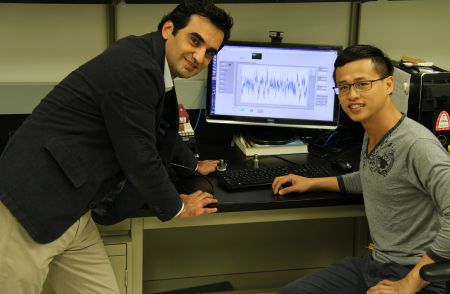
Civil engineering professor Mustafa Gül, seen here inspecting sensors with graduate student Ngoan Do, is leading a new research program to monitor the structural health of railway infrastructure in Canada.
(Edmonton) With more and more freight traffic on Canada's railways and the infrastructure itself aging, it's important to public safety, environmental protection, and economic activity that we monitor and understand the condition of this vital network.
That's what U of A Civil Engineering professor Mustafa Gül is undertaking, thanks to funding through the IC-IMPACTS, an international program supporting university researchers in Canada and India investigating areas of common interest.
Both countries have vast railway networks-Canada has more than 48,000 km of railway track-and in both countries the railways are subject to increasing loading and extreme weather conditions.
Gül's research will focus on the steel ribbons of track and bridges.
"With rails you can have a lot of different problems and conditions and we hope to identify and address the most important ones," said Gül, adding that in extreme heat, rails can experience high compressive stresses to the point that they can buckle and extreme cold can actually cause rails to snap. Add to that the effects of more and heavier loads running the rails, and the extreme conditions rails must withstand comes into focus.
Department of Civil and Environmental Engineering chair Roger Cheng and professor Vivek Bindiganavile are co-investigators in the project. The IC IMPACTS funding will support two PhD students and help purchase some equipment. The team will develop methodologies to evaluate the performance of rails and railway bridges.
The researchers will use sensors to monitor these structures and find the best way to "listen" to the sensors by correctly analyzing the data they collect.
"In addition to the changes in the structure itself, environmental conditions like snow or rain will also change the characteristics of the structure and thus the signals that a sensor sends. Even having the same train run along the same tracks on a hot day versus a cold day will send different information," he said. "But we want to extract only the most useful information from the data. Analysis of this data is really the most critical aspect."
For railway bridges, the program will develop technologies that are more problem specific.
"Railway bridges in Canada have some specific problems such as metal fatigue for steel bridges, and considering that loads for trains are increasing constantly the demands on the infrastructure are changing and the infrastructure is getting older-many of these bridges are 50 to 100 years old and are either past or getting close to their life limits, managing that infrastructure is important."
Using data from sensor-based monitoring systems will help railways improve safety and control costs.
Gül says his work will add to a body of railway-related research being conducted at the Canadian Railway Research Laboratory (CaRRL). Canada's leading railway engineering research centre, CaRRL is based in the U of A Department of Civil and Environmental Engineering and Gül has been closely collaborating with CaRRL. He'll also be working to involve the railway industry in his research.
Ultimately, he's also educating a new generation of engineers whose specialized skills will strengthen Canada's railway infrastructure.
"In addition to developing technologies to monitor and evaluate our railway infrastructure, our main focus is also creating highly qualified personnel," he said. "As much as we can, we want to educate these graduate researchers and undergraduate researchers so they become important assets to our community."